BUS301: Leadership and Management Practices at Sainsbury's - Report
VerifiedAdded on 2020/11/12
|11
|3107
|63
Report
AI Summary
This report provides a comprehensive analysis of leadership and management practices within Sainsbury's, a leading UK supermarket chain. It begins with a brief history and overview of the company, followed by an examination of its vision, leadership styles, and management strategies. The report delves into various leadership approaches, including autocratic, democratic, consultative, persuasive, and laissez-faire styles, alongside the application of leadership theories like Contingency Theory and McGregor's Theories X and Y. Specific examples are used to illustrate how these strategies are implemented within the firm. Finally, the report offers recommendations for improvement, suggesting potential leadership styles, management practices, and strategies that Sainsbury's could adopt to enhance its performance and achieve its goals, based on the research and analysis conducted.
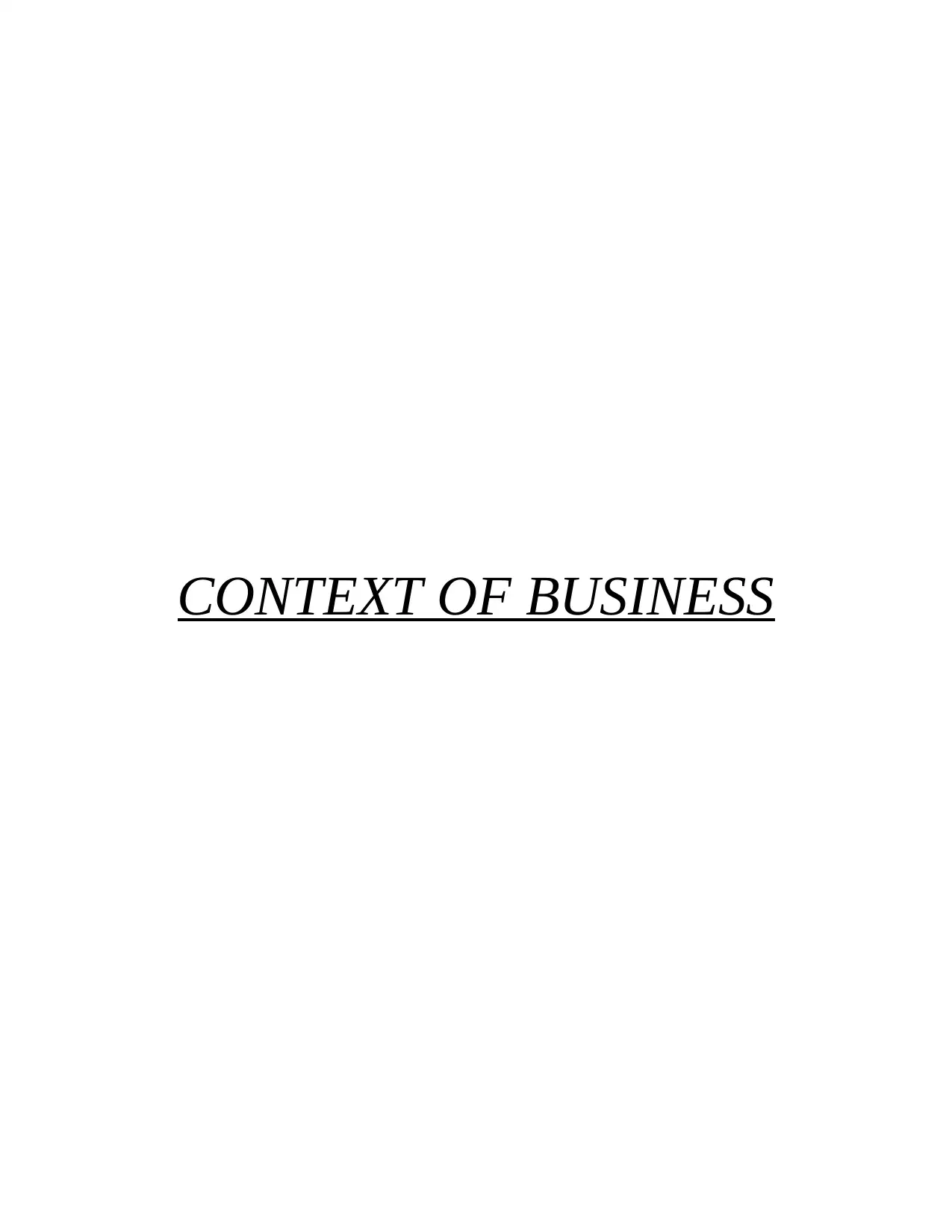
CONTEXT OF BUSINESS
Paraphrase This Document
Need a fresh take? Get an instant paraphrase of this document with our AI Paraphraser
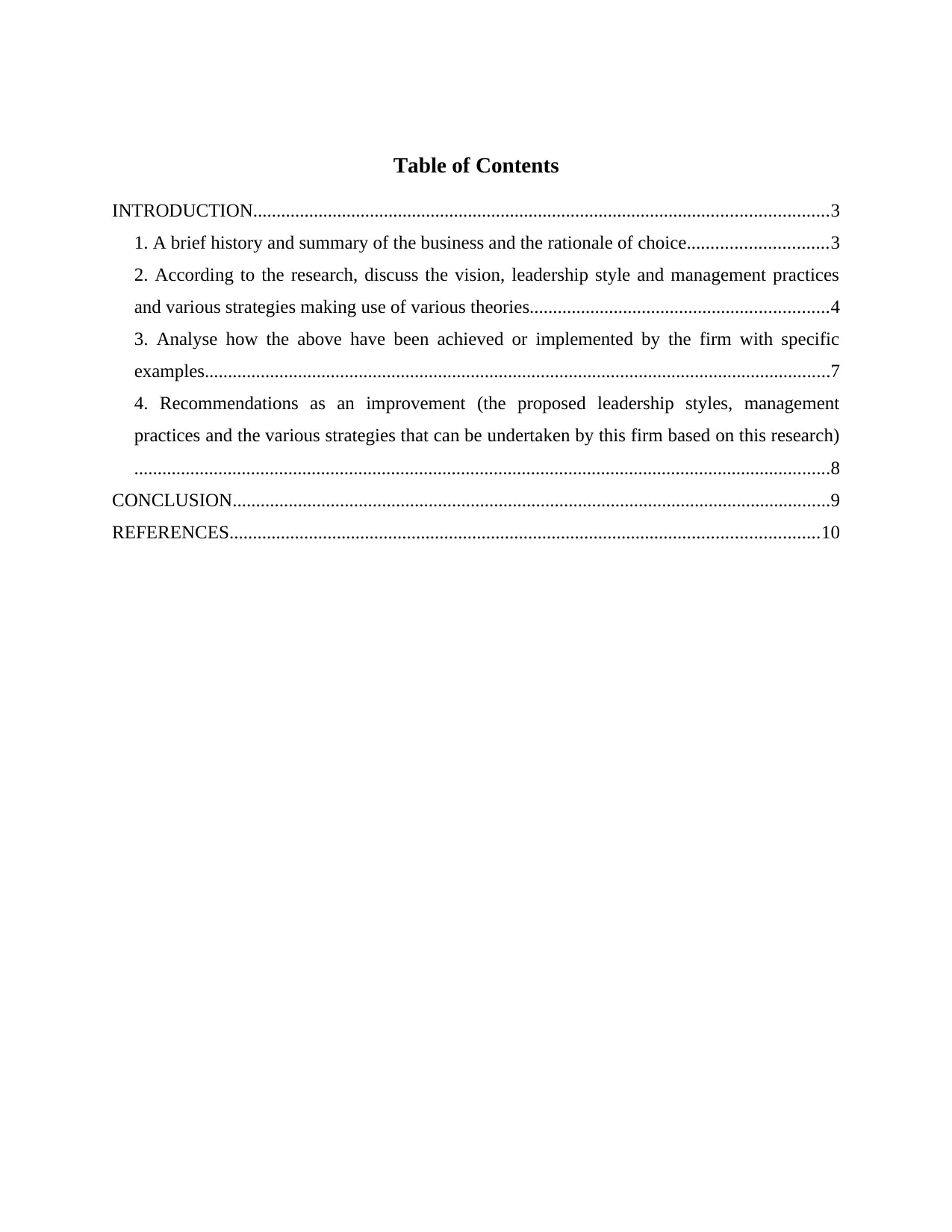
Table of Contents
INTRODUCTION...........................................................................................................................3
1. A brief history and summary of the business and the rationale of choice..............................3
2. According to the research, discuss the vision, leadership style and management practices
and various strategies making use of various theories................................................................4
3. Analyse how the above have been achieved or implemented by the firm with specific
examples......................................................................................................................................7
4. Recommendations as an improvement (the proposed leadership styles, management
practices and the various strategies that can be undertaken by this firm based on this research)
.....................................................................................................................................................8
CONCLUSION................................................................................................................................9
REFERENCES..............................................................................................................................10
INTRODUCTION...........................................................................................................................3
1. A brief history and summary of the business and the rationale of choice..............................3
2. According to the research, discuss the vision, leadership style and management practices
and various strategies making use of various theories................................................................4
3. Analyse how the above have been achieved or implemented by the firm with specific
examples......................................................................................................................................7
4. Recommendations as an improvement (the proposed leadership styles, management
practices and the various strategies that can be undertaken by this firm based on this research)
.....................................................................................................................................................8
CONCLUSION................................................................................................................................9
REFERENCES..............................................................................................................................10
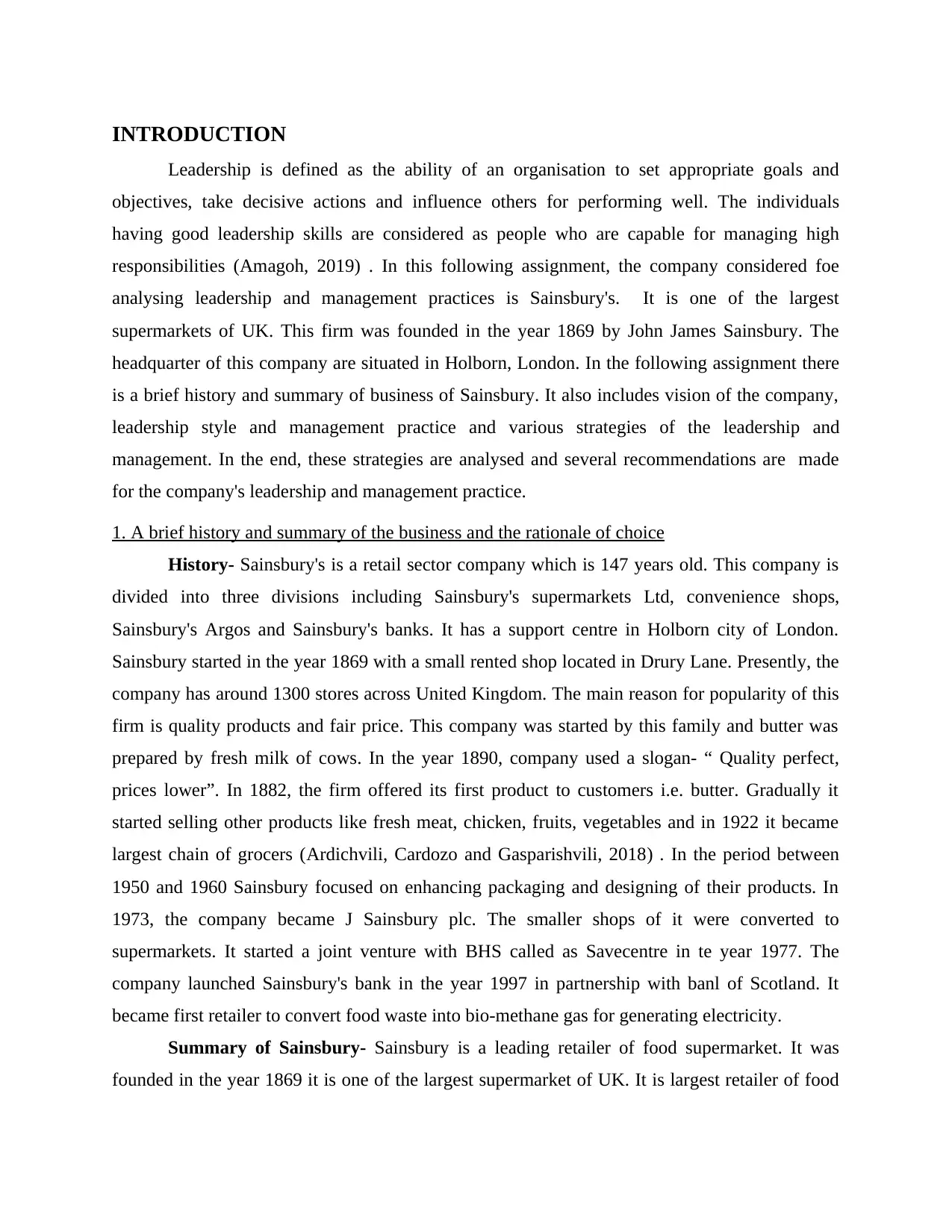
INTRODUCTION
Leadership is defined as the ability of an organisation to set appropriate goals and
objectives, take decisive actions and influence others for performing well. The individuals
having good leadership skills are considered as people who are capable for managing high
responsibilities (Amagoh, 2019) . In this following assignment, the company considered foe
analysing leadership and management practices is Sainsbury's. It is one of the largest
supermarkets of UK. This firm was founded in the year 1869 by John James Sainsbury. The
headquarter of this company are situated in Holborn, London. In the following assignment there
is a brief history and summary of business of Sainsbury. It also includes vision of the company,
leadership style and management practice and various strategies of the leadership and
management. In the end, these strategies are analysed and several recommendations are made
for the company's leadership and management practice.
1. A brief history and summary of the business and the rationale of choice
History- Sainsbury's is a retail sector company which is 147 years old. This company is
divided into three divisions including Sainsbury's supermarkets Ltd, convenience shops,
Sainsbury's Argos and Sainsbury's banks. It has a support centre in Holborn city of London.
Sainsbury started in the year 1869 with a small rented shop located in Drury Lane. Presently, the
company has around 1300 stores across United Kingdom. The main reason for popularity of this
firm is quality products and fair price. This company was started by this family and butter was
prepared by fresh milk of cows. In the year 1890, company used a slogan- “ Quality perfect,
prices lower”. In 1882, the firm offered its first product to customers i.e. butter. Gradually it
started selling other products like fresh meat, chicken, fruits, vegetables and in 1922 it became
largest chain of grocers (Ardichvili, Cardozo and Gasparishvili, 2018) . In the period between
1950 and 1960 Sainsbury focused on enhancing packaging and designing of their products. In
1973, the company became J Sainsbury plc. The smaller shops of it were converted to
supermarkets. It started a joint venture with BHS called as Savecentre in te year 1977. The
company launched Sainsbury's bank in the year 1997 in partnership with banl of Scotland. It
became first retailer to convert food waste into bio-methane gas for generating electricity.
Summary of Sainsbury- Sainsbury is a leading retailer of food supermarket. It was
founded in the year 1869 it is one of the largest supermarket of UK. It is largest retailer of food
Leadership is defined as the ability of an organisation to set appropriate goals and
objectives, take decisive actions and influence others for performing well. The individuals
having good leadership skills are considered as people who are capable for managing high
responsibilities (Amagoh, 2019) . In this following assignment, the company considered foe
analysing leadership and management practices is Sainsbury's. It is one of the largest
supermarkets of UK. This firm was founded in the year 1869 by John James Sainsbury. The
headquarter of this company are situated in Holborn, London. In the following assignment there
is a brief history and summary of business of Sainsbury. It also includes vision of the company,
leadership style and management practice and various strategies of the leadership and
management. In the end, these strategies are analysed and several recommendations are made
for the company's leadership and management practice.
1. A brief history and summary of the business and the rationale of choice
History- Sainsbury's is a retail sector company which is 147 years old. This company is
divided into three divisions including Sainsbury's supermarkets Ltd, convenience shops,
Sainsbury's Argos and Sainsbury's banks. It has a support centre in Holborn city of London.
Sainsbury started in the year 1869 with a small rented shop located in Drury Lane. Presently, the
company has around 1300 stores across United Kingdom. The main reason for popularity of this
firm is quality products and fair price. This company was started by this family and butter was
prepared by fresh milk of cows. In the year 1890, company used a slogan- “ Quality perfect,
prices lower”. In 1882, the firm offered its first product to customers i.e. butter. Gradually it
started selling other products like fresh meat, chicken, fruits, vegetables and in 1922 it became
largest chain of grocers (Ardichvili, Cardozo and Gasparishvili, 2018) . In the period between
1950 and 1960 Sainsbury focused on enhancing packaging and designing of their products. In
1973, the company became J Sainsbury plc. The smaller shops of it were converted to
supermarkets. It started a joint venture with BHS called as Savecentre in te year 1977. The
company launched Sainsbury's bank in the year 1997 in partnership with banl of Scotland. It
became first retailer to convert food waste into bio-methane gas for generating electricity.
Summary of Sainsbury- Sainsbury is a leading retailer of food supermarket. It was
founded in the year 1869 it is one of the largest supermarket of UK. It is largest retailer of food
⊘ This is a preview!⊘
Do you want full access?
Subscribe today to unlock all pages.

Trusted by 1+ million students worldwide
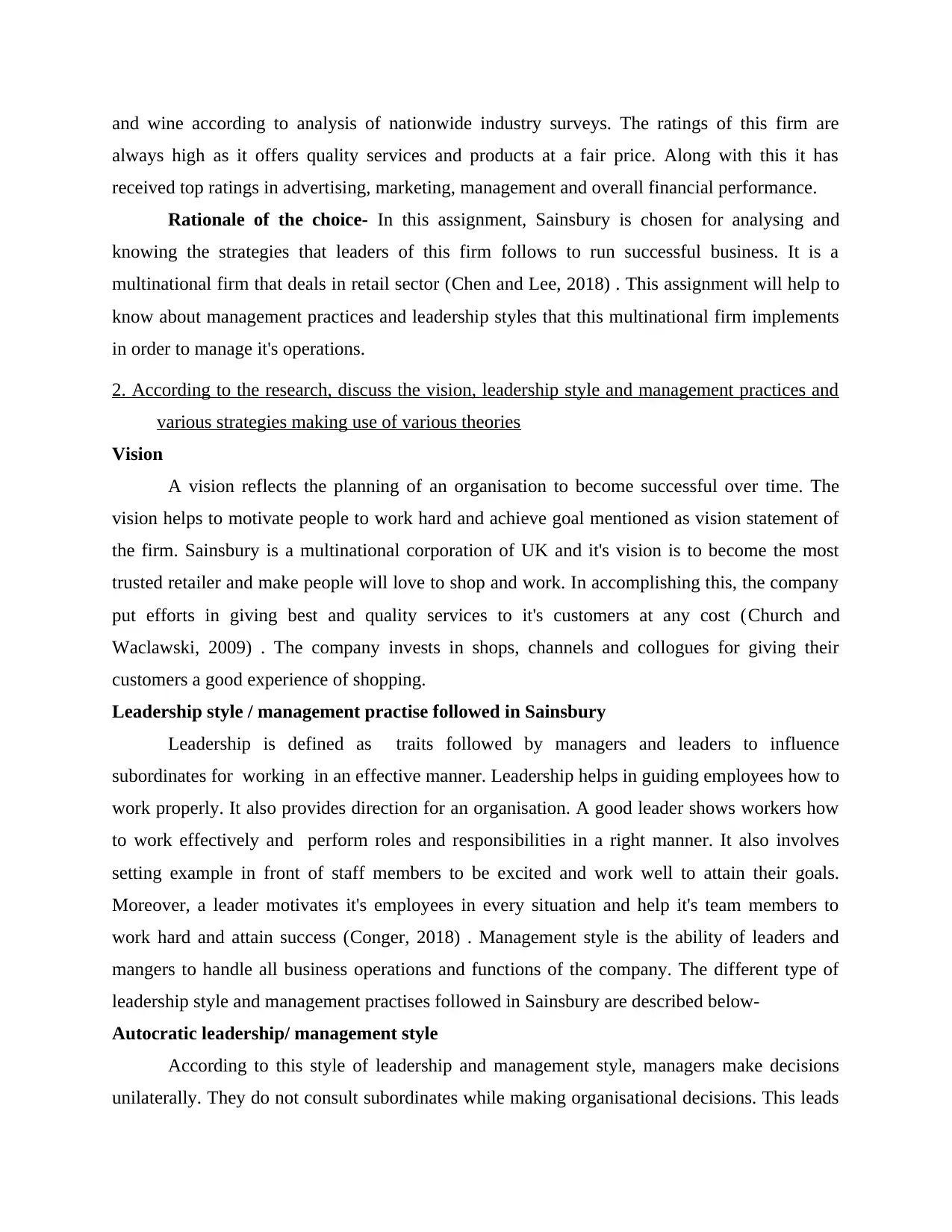
and wine according to analysis of nationwide industry surveys. The ratings of this firm are
always high as it offers quality services and products at a fair price. Along with this it has
received top ratings in advertising, marketing, management and overall financial performance.
Rationale of the choice- In this assignment, Sainsbury is chosen for analysing and
knowing the strategies that leaders of this firm follows to run successful business. It is a
multinational firm that deals in retail sector (Chen and Lee, 2018) . This assignment will help to
know about management practices and leadership styles that this multinational firm implements
in order to manage it's operations.
2. According to the research, discuss the vision, leadership style and management practices and
various strategies making use of various theories
Vision
A vision reflects the planning of an organisation to become successful over time. The
vision helps to motivate people to work hard and achieve goal mentioned as vision statement of
the firm. Sainsbury is a multinational corporation of UK and it's vision is to become the most
trusted retailer and make people will love to shop and work. In accomplishing this, the company
put efforts in giving best and quality services to it's customers at any cost (Church and
Waclawski, 2009) . The company invests in shops, channels and collogues for giving their
customers a good experience of shopping.
Leadership style / management practise followed in Sainsbury
Leadership is defined as traits followed by managers and leaders to influence
subordinates for working in an effective manner. Leadership helps in guiding employees how to
work properly. It also provides direction for an organisation. A good leader shows workers how
to work effectively and perform roles and responsibilities in a right manner. It also involves
setting example in front of staff members to be excited and work well to attain their goals.
Moreover, a leader motivates it's employees in every situation and help it's team members to
work hard and attain success (Conger, 2018) . Management style is the ability of leaders and
mangers to handle all business operations and functions of the company. The different type of
leadership style and management practises followed in Sainsbury are described below-
Autocratic leadership/ management style
According to this style of leadership and management style, managers make decisions
unilaterally. They do not consult subordinates while making organisational decisions. This leads
always high as it offers quality services and products at a fair price. Along with this it has
received top ratings in advertising, marketing, management and overall financial performance.
Rationale of the choice- In this assignment, Sainsbury is chosen for analysing and
knowing the strategies that leaders of this firm follows to run successful business. It is a
multinational firm that deals in retail sector (Chen and Lee, 2018) . This assignment will help to
know about management practices and leadership styles that this multinational firm implements
in order to manage it's operations.
2. According to the research, discuss the vision, leadership style and management practices and
various strategies making use of various theories
Vision
A vision reflects the planning of an organisation to become successful over time. The
vision helps to motivate people to work hard and achieve goal mentioned as vision statement of
the firm. Sainsbury is a multinational corporation of UK and it's vision is to become the most
trusted retailer and make people will love to shop and work. In accomplishing this, the company
put efforts in giving best and quality services to it's customers at any cost (Church and
Waclawski, 2009) . The company invests in shops, channels and collogues for giving their
customers a good experience of shopping.
Leadership style / management practise followed in Sainsbury
Leadership is defined as traits followed by managers and leaders to influence
subordinates for working in an effective manner. Leadership helps in guiding employees how to
work properly. It also provides direction for an organisation. A good leader shows workers how
to work effectively and perform roles and responsibilities in a right manner. It also involves
setting example in front of staff members to be excited and work well to attain their goals.
Moreover, a leader motivates it's employees in every situation and help it's team members to
work hard and attain success (Conger, 2018) . Management style is the ability of leaders and
mangers to handle all business operations and functions of the company. The different type of
leadership style and management practises followed in Sainsbury are described below-
Autocratic leadership/ management style
According to this style of leadership and management style, managers make decisions
unilaterally. They do not consult subordinates while making organisational decisions. This leads
Paraphrase This Document
Need a fresh take? Get an instant paraphrase of this document with our AI Paraphraser
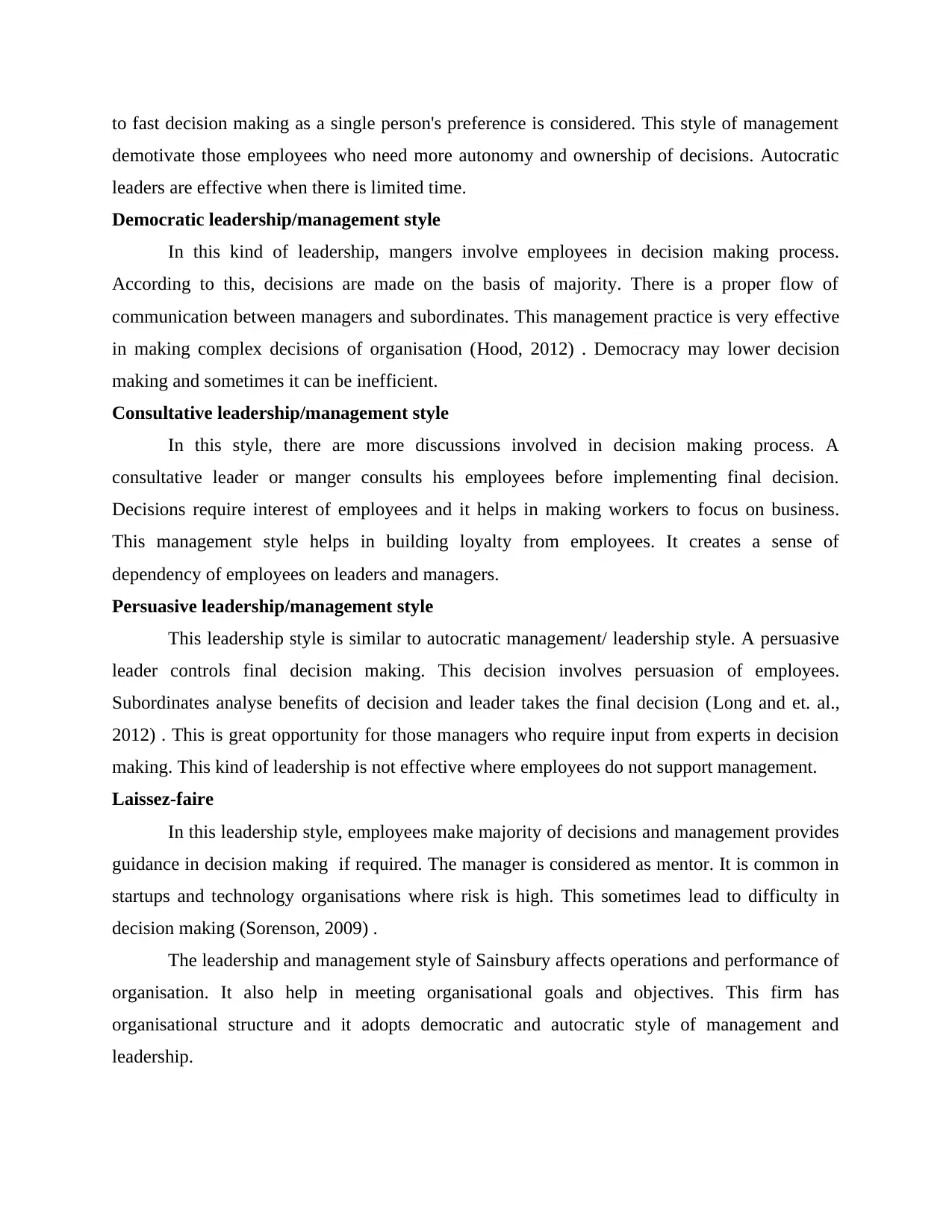
to fast decision making as a single person's preference is considered. This style of management
demotivate those employees who need more autonomy and ownership of decisions. Autocratic
leaders are effective when there is limited time.
Democratic leadership/management style
In this kind of leadership, mangers involve employees in decision making process.
According to this, decisions are made on the basis of majority. There is a proper flow of
communication between managers and subordinates. This management practice is very effective
in making complex decisions of organisation (Hood, 2012) . Democracy may lower decision
making and sometimes it can be inefficient.
Consultative leadership/management style
In this style, there are more discussions involved in decision making process. A
consultative leader or manger consults his employees before implementing final decision.
Decisions require interest of employees and it helps in making workers to focus on business.
This management style helps in building loyalty from employees. It creates a sense of
dependency of employees on leaders and managers.
Persuasive leadership/management style
This leadership style is similar to autocratic management/ leadership style. A persuasive
leader controls final decision making. This decision involves persuasion of employees.
Subordinates analyse benefits of decision and leader takes the final decision (Long and et. al.,
2012) . This is great opportunity for those managers who require input from experts in decision
making. This kind of leadership is not effective where employees do not support management.
Laissez-faire
In this leadership style, employees make majority of decisions and management provides
guidance in decision making if required. The manager is considered as mentor. It is common in
startups and technology organisations where risk is high. This sometimes lead to difficulty in
decision making (Sorenson, 2009) .
The leadership and management style of Sainsbury affects operations and performance of
organisation. It also help in meeting organisational goals and objectives. This firm has
organisational structure and it adopts democratic and autocratic style of management and
leadership.
demotivate those employees who need more autonomy and ownership of decisions. Autocratic
leaders are effective when there is limited time.
Democratic leadership/management style
In this kind of leadership, mangers involve employees in decision making process.
According to this, decisions are made on the basis of majority. There is a proper flow of
communication between managers and subordinates. This management practice is very effective
in making complex decisions of organisation (Hood, 2012) . Democracy may lower decision
making and sometimes it can be inefficient.
Consultative leadership/management style
In this style, there are more discussions involved in decision making process. A
consultative leader or manger consults his employees before implementing final decision.
Decisions require interest of employees and it helps in making workers to focus on business.
This management style helps in building loyalty from employees. It creates a sense of
dependency of employees on leaders and managers.
Persuasive leadership/management style
This leadership style is similar to autocratic management/ leadership style. A persuasive
leader controls final decision making. This decision involves persuasion of employees.
Subordinates analyse benefits of decision and leader takes the final decision (Long and et. al.,
2012) . This is great opportunity for those managers who require input from experts in decision
making. This kind of leadership is not effective where employees do not support management.
Laissez-faire
In this leadership style, employees make majority of decisions and management provides
guidance in decision making if required. The manager is considered as mentor. It is common in
startups and technology organisations where risk is high. This sometimes lead to difficulty in
decision making (Sorenson, 2009) .
The leadership and management style of Sainsbury affects operations and performance of
organisation. It also help in meeting organisational goals and objectives. This firm has
organisational structure and it adopts democratic and autocratic style of management and
leadership.
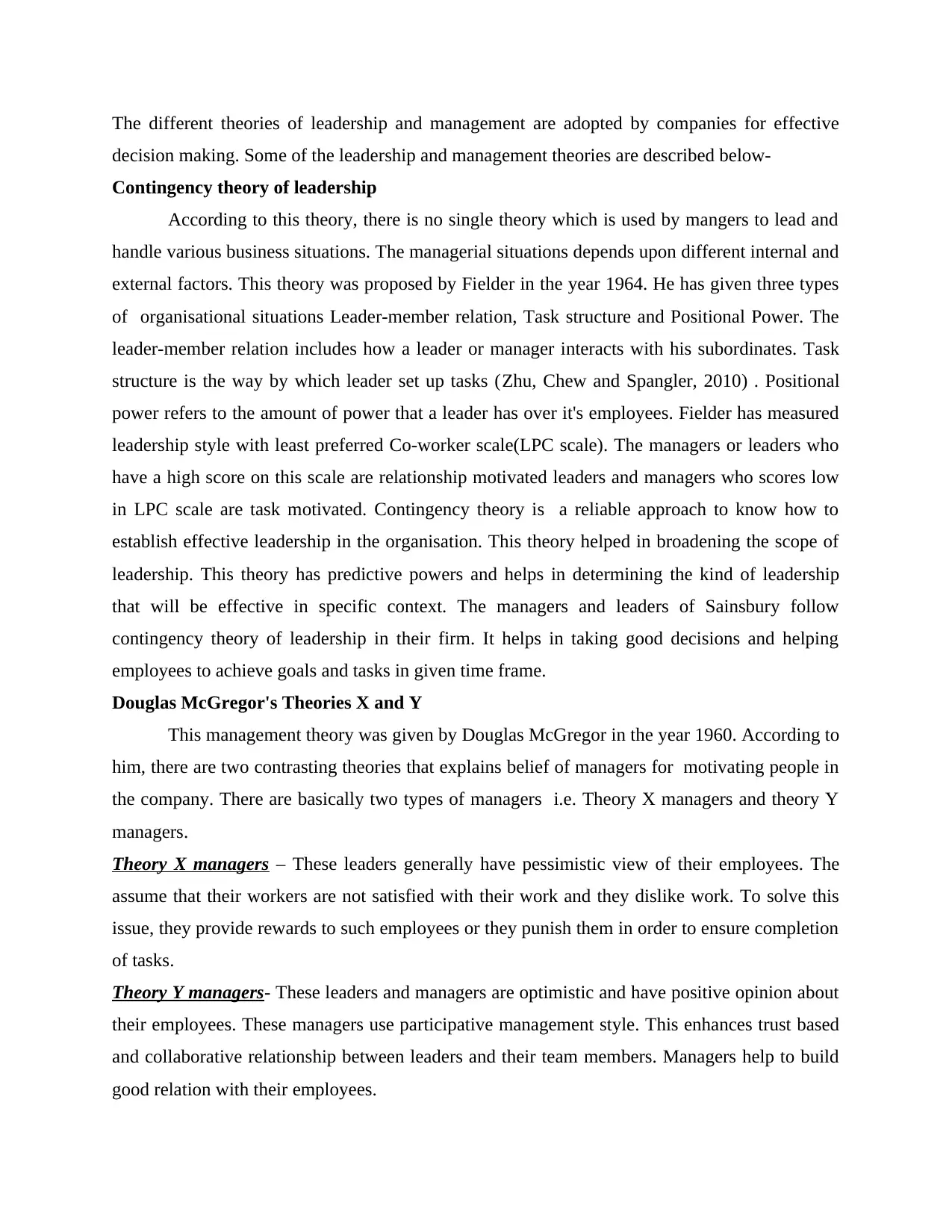
The different theories of leadership and management are adopted by companies for effective
decision making. Some of the leadership and management theories are described below-
Contingency theory of leadership
According to this theory, there is no single theory which is used by mangers to lead and
handle various business situations. The managerial situations depends upon different internal and
external factors. This theory was proposed by Fielder in the year 1964. He has given three types
of organisational situations Leader-member relation, Task structure and Positional Power. The
leader-member relation includes how a leader or manager interacts with his subordinates. Task
structure is the way by which leader set up tasks (Zhu, Chew and Spangler, 2010) . Positional
power refers to the amount of power that a leader has over it's employees. Fielder has measured
leadership style with least preferred Co-worker scale(LPC scale). The managers or leaders who
have a high score on this scale are relationship motivated leaders and managers who scores low
in LPC scale are task motivated. Contingency theory is a reliable approach to know how to
establish effective leadership in the organisation. This theory helped in broadening the scope of
leadership. This theory has predictive powers and helps in determining the kind of leadership
that will be effective in specific context. The managers and leaders of Sainsbury follow
contingency theory of leadership in their firm. It helps in taking good decisions and helping
employees to achieve goals and tasks in given time frame.
Douglas McGregor's Theories X and Y
This management theory was given by Douglas McGregor in the year 1960. According to
him, there are two contrasting theories that explains belief of managers for motivating people in
the company. There are basically two types of managers i.e. Theory X managers and theory Y
managers.
Theory X managers – These leaders generally have pessimistic view of their employees. The
assume that their workers are not satisfied with their work and they dislike work. To solve this
issue, they provide rewards to such employees or they punish them in order to ensure completion
of tasks.
Theory Y managers- These leaders and managers are optimistic and have positive opinion about
their employees. These managers use participative management style. This enhances trust based
and collaborative relationship between leaders and their team members. Managers help to build
good relation with their employees.
decision making. Some of the leadership and management theories are described below-
Contingency theory of leadership
According to this theory, there is no single theory which is used by mangers to lead and
handle various business situations. The managerial situations depends upon different internal and
external factors. This theory was proposed by Fielder in the year 1964. He has given three types
of organisational situations Leader-member relation, Task structure and Positional Power. The
leader-member relation includes how a leader or manager interacts with his subordinates. Task
structure is the way by which leader set up tasks (Zhu, Chew and Spangler, 2010) . Positional
power refers to the amount of power that a leader has over it's employees. Fielder has measured
leadership style with least preferred Co-worker scale(LPC scale). The managers or leaders who
have a high score on this scale are relationship motivated leaders and managers who scores low
in LPC scale are task motivated. Contingency theory is a reliable approach to know how to
establish effective leadership in the organisation. This theory helped in broadening the scope of
leadership. This theory has predictive powers and helps in determining the kind of leadership
that will be effective in specific context. The managers and leaders of Sainsbury follow
contingency theory of leadership in their firm. It helps in taking good decisions and helping
employees to achieve goals and tasks in given time frame.
Douglas McGregor's Theories X and Y
This management theory was given by Douglas McGregor in the year 1960. According to
him, there are two contrasting theories that explains belief of managers for motivating people in
the company. There are basically two types of managers i.e. Theory X managers and theory Y
managers.
Theory X managers – These leaders generally have pessimistic view of their employees. The
assume that their workers are not satisfied with their work and they dislike work. To solve this
issue, they provide rewards to such employees or they punish them in order to ensure completion
of tasks.
Theory Y managers- These leaders and managers are optimistic and have positive opinion about
their employees. These managers use participative management style. This enhances trust based
and collaborative relationship between leaders and their team members. Managers help to build
good relation with their employees.
⊘ This is a preview!⊘
Do you want full access?
Subscribe today to unlock all pages.

Trusted by 1+ million students worldwide
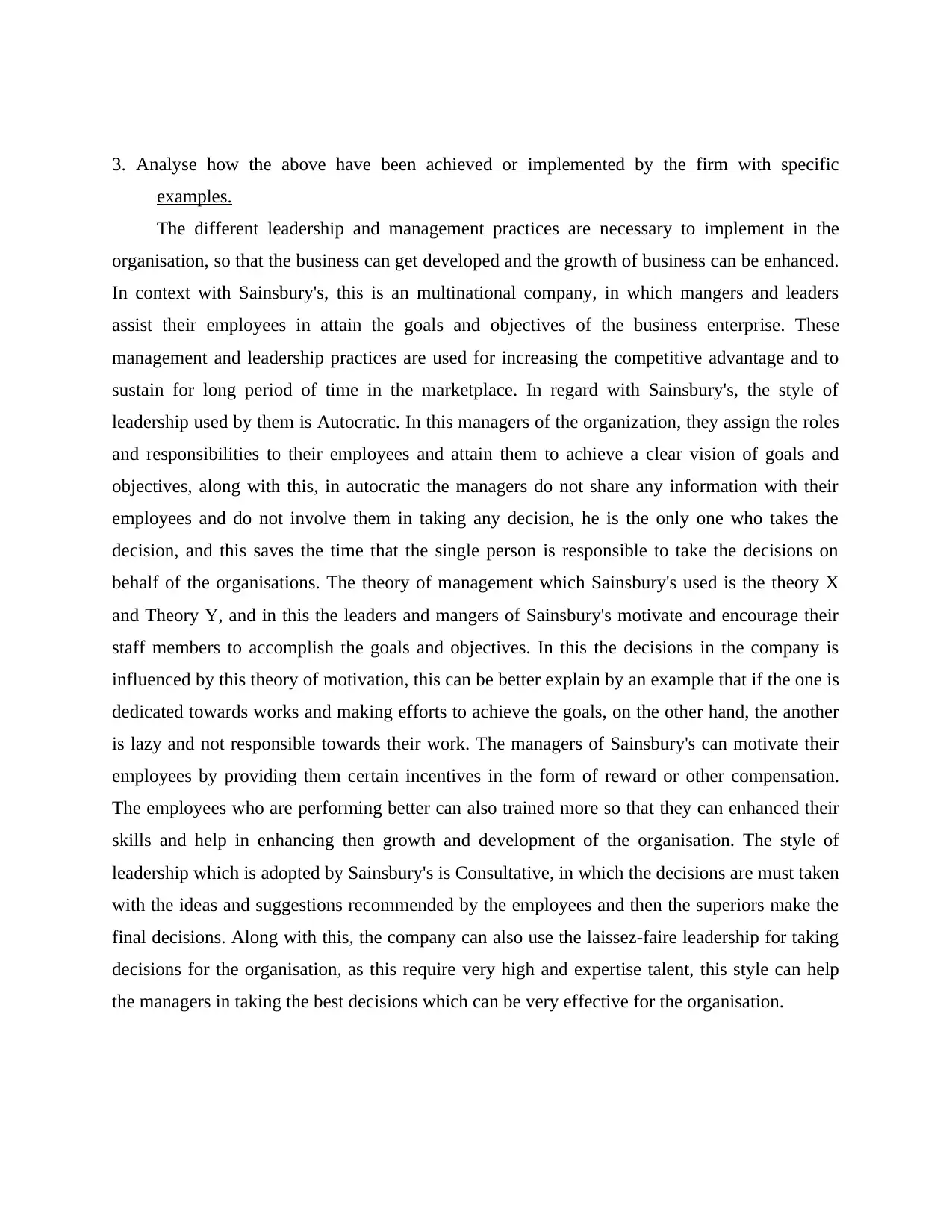
3. Analyse how the above have been achieved or implemented by the firm with specific
examples.
The different leadership and management practices are necessary to implement in the
organisation, so that the business can get developed and the growth of business can be enhanced.
In context with Sainsbury's, this is an multinational company, in which mangers and leaders
assist their employees in attain the goals and objectives of the business enterprise. These
management and leadership practices are used for increasing the competitive advantage and to
sustain for long period of time in the marketplace. In regard with Sainsbury's, the style of
leadership used by them is Autocratic. In this managers of the organization, they assign the roles
and responsibilities to their employees and attain them to achieve a clear vision of goals and
objectives, along with this, in autocratic the managers do not share any information with their
employees and do not involve them in taking any decision, he is the only one who takes the
decision, and this saves the time that the single person is responsible to take the decisions on
behalf of the organisations. The theory of management which Sainsbury's used is the theory X
and Theory Y, and in this the leaders and mangers of Sainsbury's motivate and encourage their
staff members to accomplish the goals and objectives. In this the decisions in the company is
influenced by this theory of motivation, this can be better explain by an example that if the one is
dedicated towards works and making efforts to achieve the goals, on the other hand, the another
is lazy and not responsible towards their work. The managers of Sainsbury's can motivate their
employees by providing them certain incentives in the form of reward or other compensation.
The employees who are performing better can also trained more so that they can enhanced their
skills and help in enhancing then growth and development of the organisation. The style of
leadership which is adopted by Sainsbury's is Consultative, in which the decisions are must taken
with the ideas and suggestions recommended by the employees and then the superiors make the
final decisions. Along with this, the company can also use the laissez-faire leadership for taking
decisions for the organisation, as this require very high and expertise talent, this style can help
the managers in taking the best decisions which can be very effective for the organisation.
examples.
The different leadership and management practices are necessary to implement in the
organisation, so that the business can get developed and the growth of business can be enhanced.
In context with Sainsbury's, this is an multinational company, in which mangers and leaders
assist their employees in attain the goals and objectives of the business enterprise. These
management and leadership practices are used for increasing the competitive advantage and to
sustain for long period of time in the marketplace. In regard with Sainsbury's, the style of
leadership used by them is Autocratic. In this managers of the organization, they assign the roles
and responsibilities to their employees and attain them to achieve a clear vision of goals and
objectives, along with this, in autocratic the managers do not share any information with their
employees and do not involve them in taking any decision, he is the only one who takes the
decision, and this saves the time that the single person is responsible to take the decisions on
behalf of the organisations. The theory of management which Sainsbury's used is the theory X
and Theory Y, and in this the leaders and mangers of Sainsbury's motivate and encourage their
staff members to accomplish the goals and objectives. In this the decisions in the company is
influenced by this theory of motivation, this can be better explain by an example that if the one is
dedicated towards works and making efforts to achieve the goals, on the other hand, the another
is lazy and not responsible towards their work. The managers of Sainsbury's can motivate their
employees by providing them certain incentives in the form of reward or other compensation.
The employees who are performing better can also trained more so that they can enhanced their
skills and help in enhancing then growth and development of the organisation. The style of
leadership which is adopted by Sainsbury's is Consultative, in which the decisions are must taken
with the ideas and suggestions recommended by the employees and then the superiors make the
final decisions. Along with this, the company can also use the laissez-faire leadership for taking
decisions for the organisation, as this require very high and expertise talent, this style can help
the managers in taking the best decisions which can be very effective for the organisation.
Paraphrase This Document
Need a fresh take? Get an instant paraphrase of this document with our AI Paraphraser
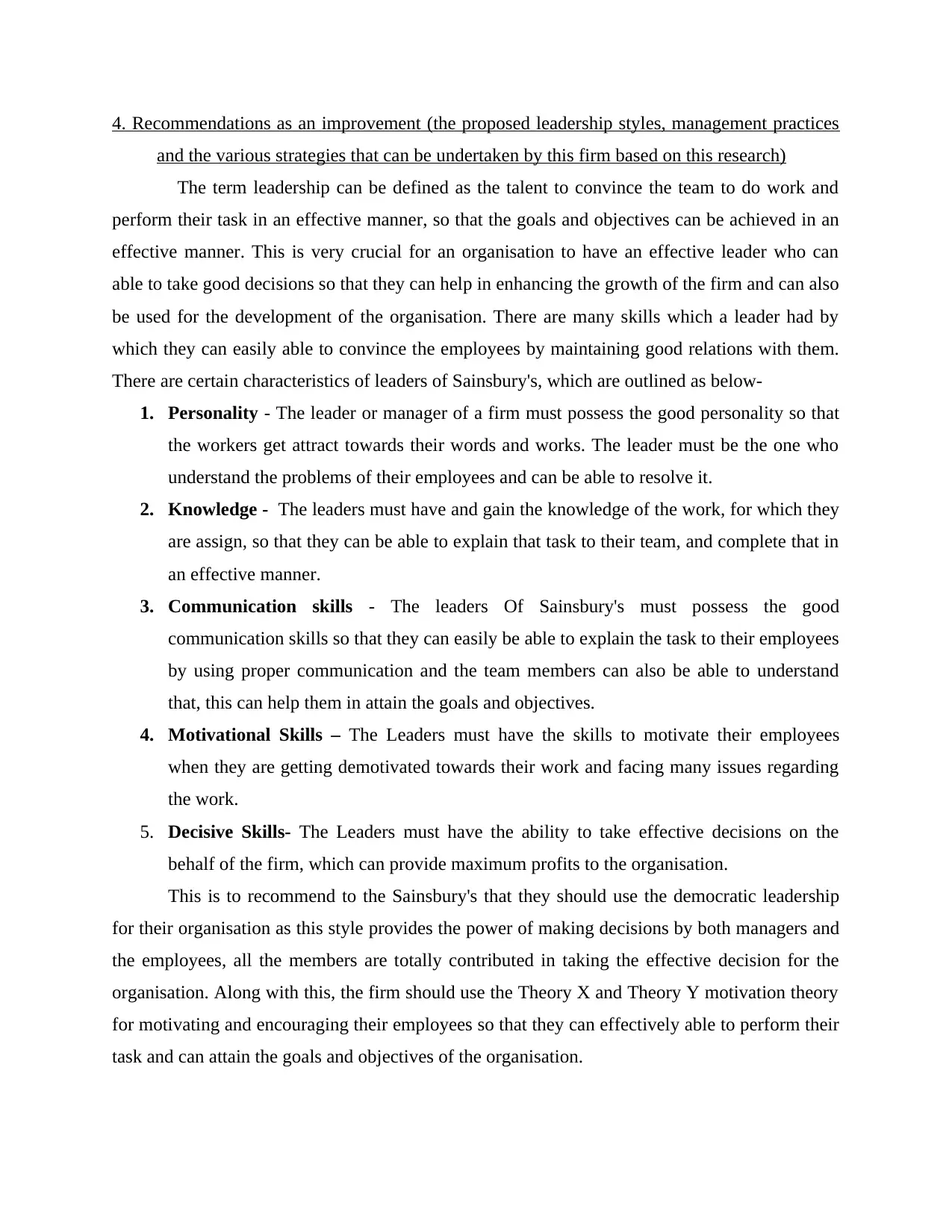
4. Recommendations as an improvement (the proposed leadership styles, management practices
and the various strategies that can be undertaken by this firm based on this research)
The term leadership can be defined as the talent to convince the team to do work and
perform their task in an effective manner, so that the goals and objectives can be achieved in an
effective manner. This is very crucial for an organisation to have an effective leader who can
able to take good decisions so that they can help in enhancing the growth of the firm and can also
be used for the development of the organisation. There are many skills which a leader had by
which they can easily able to convince the employees by maintaining good relations with them.
There are certain characteristics of leaders of Sainsbury's, which are outlined as below-
1. Personality - The leader or manager of a firm must possess the good personality so that
the workers get attract towards their words and works. The leader must be the one who
understand the problems of their employees and can be able to resolve it.
2. Knowledge - The leaders must have and gain the knowledge of the work, for which they
are assign, so that they can be able to explain that task to their team, and complete that in
an effective manner.
3. Communication skills - The leaders Of Sainsbury's must possess the good
communication skills so that they can easily be able to explain the task to their employees
by using proper communication and the team members can also be able to understand
that, this can help them in attain the goals and objectives.
4. Motivational Skills – The Leaders must have the skills to motivate their employees
when they are getting demotivated towards their work and facing many issues regarding
the work.
5. Decisive Skills- The Leaders must have the ability to take effective decisions on the
behalf of the firm, which can provide maximum profits to the organisation.
This is to recommend to the Sainsbury's that they should use the democratic leadership
for their organisation as this style provides the power of making decisions by both managers and
the employees, all the members are totally contributed in taking the effective decision for the
organisation. Along with this, the firm should use the Theory X and Theory Y motivation theory
for motivating and encouraging their employees so that they can effectively able to perform their
task and can attain the goals and objectives of the organisation.
and the various strategies that can be undertaken by this firm based on this research)
The term leadership can be defined as the talent to convince the team to do work and
perform their task in an effective manner, so that the goals and objectives can be achieved in an
effective manner. This is very crucial for an organisation to have an effective leader who can
able to take good decisions so that they can help in enhancing the growth of the firm and can also
be used for the development of the organisation. There are many skills which a leader had by
which they can easily able to convince the employees by maintaining good relations with them.
There are certain characteristics of leaders of Sainsbury's, which are outlined as below-
1. Personality - The leader or manager of a firm must possess the good personality so that
the workers get attract towards their words and works. The leader must be the one who
understand the problems of their employees and can be able to resolve it.
2. Knowledge - The leaders must have and gain the knowledge of the work, for which they
are assign, so that they can be able to explain that task to their team, and complete that in
an effective manner.
3. Communication skills - The leaders Of Sainsbury's must possess the good
communication skills so that they can easily be able to explain the task to their employees
by using proper communication and the team members can also be able to understand
that, this can help them in attain the goals and objectives.
4. Motivational Skills – The Leaders must have the skills to motivate their employees
when they are getting demotivated towards their work and facing many issues regarding
the work.
5. Decisive Skills- The Leaders must have the ability to take effective decisions on the
behalf of the firm, which can provide maximum profits to the organisation.
This is to recommend to the Sainsbury's that they should use the democratic leadership
for their organisation as this style provides the power of making decisions by both managers and
the employees, all the members are totally contributed in taking the effective decision for the
organisation. Along with this, the firm should use the Theory X and Theory Y motivation theory
for motivating and encouraging their employees so that they can effectively able to perform their
task and can attain the goals and objectives of the organisation.
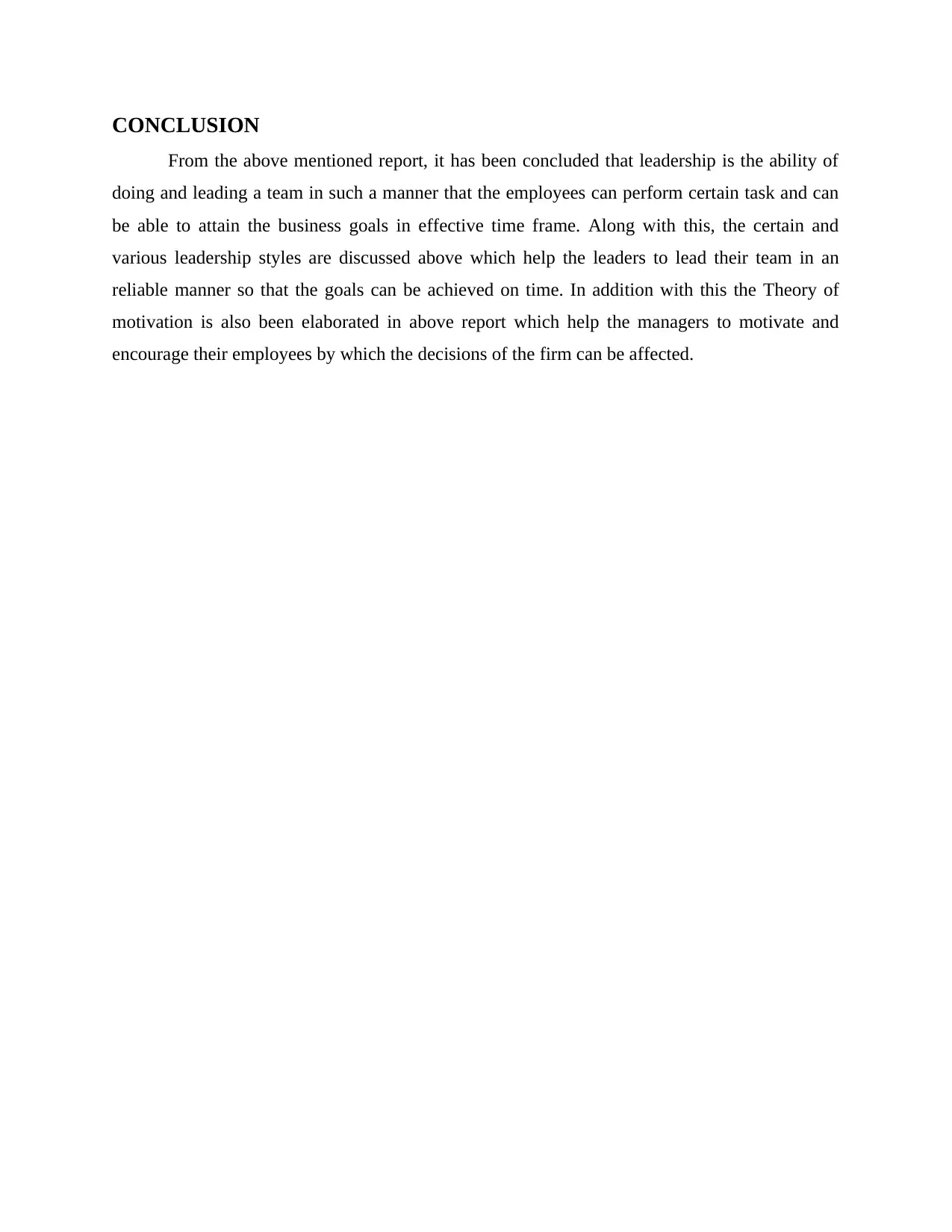
CONCLUSION
From the above mentioned report, it has been concluded that leadership is the ability of
doing and leading a team in such a manner that the employees can perform certain task and can
be able to attain the business goals in effective time frame. Along with this, the certain and
various leadership styles are discussed above which help the leaders to lead their team in an
reliable manner so that the goals can be achieved on time. In addition with this the Theory of
motivation is also been elaborated in above report which help the managers to motivate and
encourage their employees by which the decisions of the firm can be affected.
From the above mentioned report, it has been concluded that leadership is the ability of
doing and leading a team in such a manner that the employees can perform certain task and can
be able to attain the business goals in effective time frame. Along with this, the certain and
various leadership styles are discussed above which help the leaders to lead their team in an
reliable manner so that the goals can be achieved on time. In addition with this the Theory of
motivation is also been elaborated in above report which help the managers to motivate and
encourage their employees by which the decisions of the firm can be affected.
⊘ This is a preview!⊘
Do you want full access?
Subscribe today to unlock all pages.

Trusted by 1+ million students worldwide
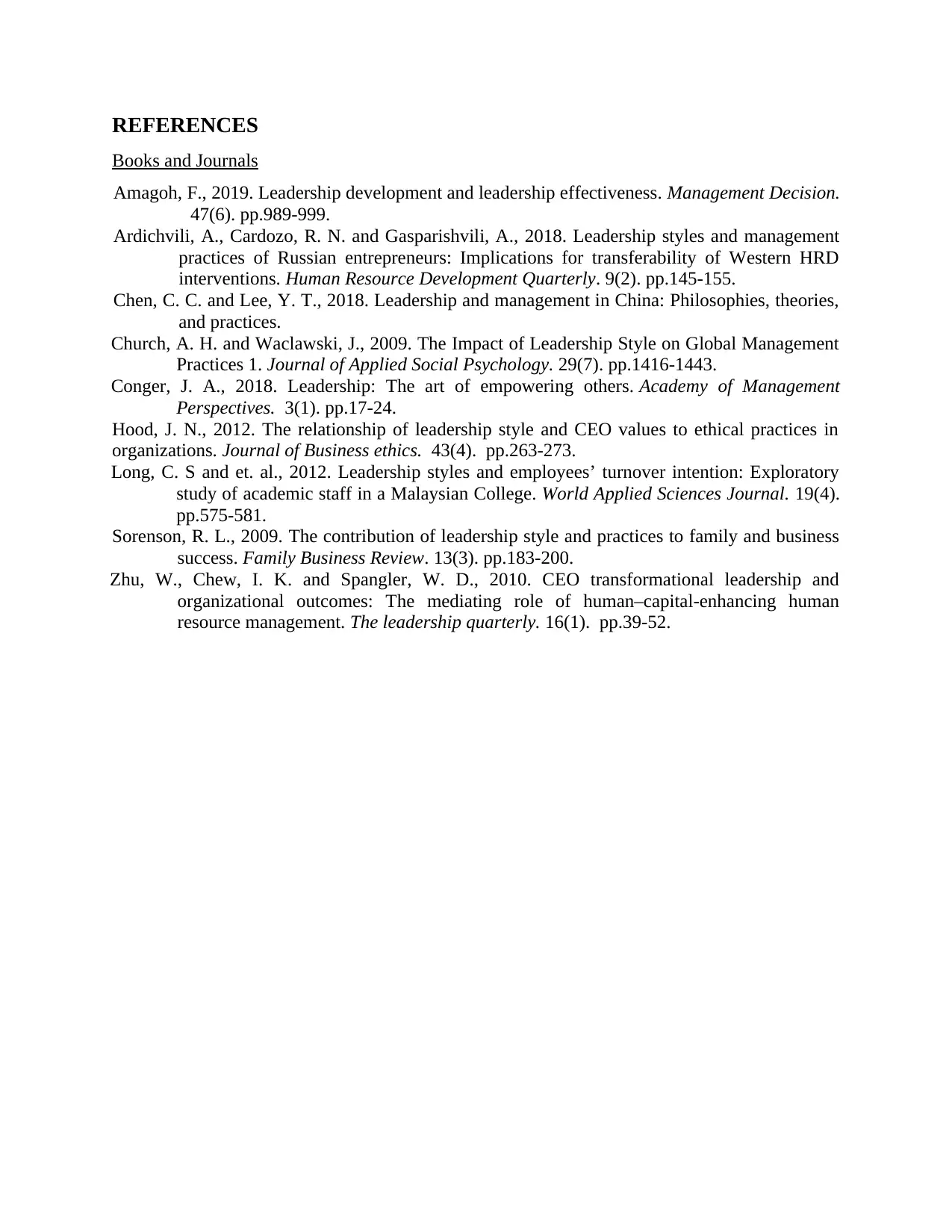
REFERENCES
Books and Journals
Amagoh, F., 2019. Leadership development and leadership effectiveness. Management Decision.
47(6). pp.989-999.
Ardichvili, A., Cardozo, R. N. and Gasparishvili, A., 2018. Leadership styles and management
practices of Russian entrepreneurs: Implications for transferability of Western HRD
interventions. Human Resource Development Quarterly. 9(2). pp.145-155.
Chen, C. C. and Lee, Y. T., 2018. Leadership and management in China: Philosophies, theories,
and practices.
Church, A. H. and Waclawski, J., 2009. The Impact of Leadership Style on Global Management
Practices 1. Journal of Applied Social Psychology. 29(7). pp.1416-1443.
Conger, J. A., 2018. Leadership: The art of empowering others. Academy of Management
Perspectives. 3(1). pp.17-24.
Hood, J. N., 2012. The relationship of leadership style and CEO values to ethical practices in
organizations. Journal of Business ethics. 43(4). pp.263-273.
Long, C. S and et. al., 2012. Leadership styles and employees’ turnover intention: Exploratory
study of academic staff in a Malaysian College. World Applied Sciences Journal. 19(4).
pp.575-581.
Sorenson, R. L., 2009. The contribution of leadership style and practices to family and business
success. Family Business Review. 13(3). pp.183-200.
Zhu, W., Chew, I. K. and Spangler, W. D., 2010. CEO transformational leadership and
organizational outcomes: The mediating role of human–capital-enhancing human
resource management. The leadership quarterly. 16(1). pp.39-52.
Books and Journals
Amagoh, F., 2019. Leadership development and leadership effectiveness. Management Decision.
47(6). pp.989-999.
Ardichvili, A., Cardozo, R. N. and Gasparishvili, A., 2018. Leadership styles and management
practices of Russian entrepreneurs: Implications for transferability of Western HRD
interventions. Human Resource Development Quarterly. 9(2). pp.145-155.
Chen, C. C. and Lee, Y. T., 2018. Leadership and management in China: Philosophies, theories,
and practices.
Church, A. H. and Waclawski, J., 2009. The Impact of Leadership Style on Global Management
Practices 1. Journal of Applied Social Psychology. 29(7). pp.1416-1443.
Conger, J. A., 2018. Leadership: The art of empowering others. Academy of Management
Perspectives. 3(1). pp.17-24.
Hood, J. N., 2012. The relationship of leadership style and CEO values to ethical practices in
organizations. Journal of Business ethics. 43(4). pp.263-273.
Long, C. S and et. al., 2012. Leadership styles and employees’ turnover intention: Exploratory
study of academic staff in a Malaysian College. World Applied Sciences Journal. 19(4).
pp.575-581.
Sorenson, R. L., 2009. The contribution of leadership style and practices to family and business
success. Family Business Review. 13(3). pp.183-200.
Zhu, W., Chew, I. K. and Spangler, W. D., 2010. CEO transformational leadership and
organizational outcomes: The mediating role of human–capital-enhancing human
resource management. The leadership quarterly. 16(1). pp.39-52.
Paraphrase This Document
Need a fresh take? Get an instant paraphrase of this document with our AI Paraphraser

1 out of 11
Related Documents
Your All-in-One AI-Powered Toolkit for Academic Success.
+13062052269
info@desklib.com
Available 24*7 on WhatsApp / Email
![[object Object]](/_next/static/media/star-bottom.7253800d.svg)
Unlock your academic potential
Copyright © 2020–2025 A2Z Services. All Rights Reserved. Developed and managed by ZUCOL.




